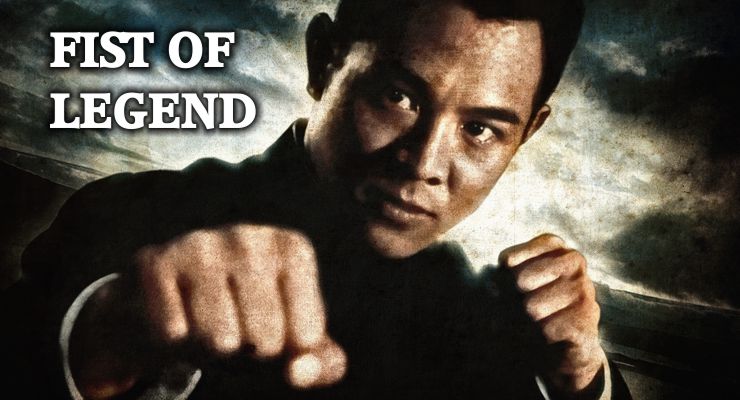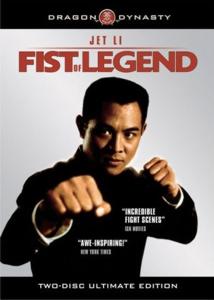
Bruce Lee’s Enter the Dragon (1973) held the undisputed title for best martial-arts movie of all time for nearly 20 years. But two recent releases have knocked the classic off of my No. 1 spot. The first of these is Fist of Legend (1994), a Jet Li remake of the Bruce Lee classic Chinese Connection or Fist of Fury (1972).
The background.
With First of Legend (1994), Li completes his cycle starring as just about every famous true-life martial folk hero in Chinese history. Others he has played are Ming revolutionary and Hung Gar Kung Fu founder Hung Hei Kwoon (“New Hero of Shaolin”), Ming revolutionary Fong Sai Yuk (“Fong Sai Yuk I” and “Fong Sai Yuk II”), fabled Taoist master and (possibly) the inventor of Taijiquan Zhang San Feng (“Tai Chi Master”), and, of course, turn-of-the-century hero, fighter and doctor Wong Fei Hung (the “Once Upon a Time in China” series).

I misspoke myself, however. In First of Legend (1994), Li doesn’t play the legendary Huo Yuen Jia (1869-1909), but his student, Chen Zhen. (Li is set to correct that oversight by playing Huo in a “Fist of Legend” prequel, however.)
Who was Huo Yuen Jia? He was a turn-of-the-20th-century martial artist who gained fame by defeating a variety of foreign fighters in challenge matches; this earned him the love of the Chinese people, who at the time, felt isolated, powerless and wronged by the many Western imperialist powers that were at the time, trying to carve up China into their own private fiefdoms. Huo was born into a family of martial artists, but was forbidden to learn his family art because he was so sickly a child. Accounts differ, but somehow, Huo managed to finagle instruction from somewhere and became a master of several styles, including the famed “Mi Zhong Chuan” – the lost-track fist. The style is known for it’s fast, intricate and sophisticated footwork, which allows a practitioner to attack and evade strikes so swiftly and efficiently that he can often position himself behind his opponent without the opponent figuring out what’s going on. The style specializes in confusing opponents through its sheer unpredictability.
A product of his times, Huo eventually founded the famed “Jing Wu Guan” – the “Pure Martial School,” where students could train not just with him, but with any master who wanted to teach what he knew. Well-known masters of all styles were invited to visit, learn and share what knowledge they had. And many did – wing chun’s famous Yip Man, for instance, spent time in Jing Wu. Huo advocated widespread martial arts training for all Chinese as a way to make the country healthier, stronger, and better able to resist an invasion. Branches of the school still exist today in Shanghai and Hong Kong.
Huo died shortly after a match with a Japanese challenger. While there was never any direct evidence of foul play, rumors soon spread that Huo had been poisoned before the fight. It is a possible explanation for the sudden death of a skilled fighter and apparently healthy man, and it is widely believed today. But it is also possible that despite his training, Huo still had a weak constitution that was easily overcome by the stress of fighting. Or, that some lingering internal injury from a previous challenge went undetected but finally blossomed into something more serious. Or, that Huo strained his internal energy too much with his heavy schedule of teaching, fighting and public works. We might never know the answer. But for dramatic purposes, both “Chinese Connection” and “Fist of Legend” have Huo being poisoned by the Japanese.
The movie.
The main plot points in First of Legend (1994) is identical to “Chinese Connection”: Chen Zhen, a martial-arts student of the famed Huo Yuen Jia, is attending school abroad when he learns of his master’s death and returns home to the funeral. Refusing to buy the official cause of death, Chen investigates and finds that Huo was poisoned on orders from the Japanese government. Along the way he beats the crap out of many Japanese, killing some of them. The politically powerful Japanese attack Chen’s Jin Woo school in retaliation and demand Chen’s arrest; Chen exacts final revenge, then turns himself in after getting a guarantee that his school will be protected from future harassment.
But the overall storyline of First of Legend (1994) is far richer and better than the one in Chinese Connection. Fist of Legend features likeable, respectable and honorable Japanese characters and not just the crazy, dirty, lecherous and villainous variety found in Chinese Connection. Jet Li’s Chen Zhen is more than just a crazy revenge-obsessed rabid animal, but a thoughtful, rational, adaptable man with an evolved sense of honor. And the Chinese are shown to be just as capable of cruelty and racism as the Japanese.
The fights.
As you might know, Bruce Lee as a martial artist was known for being very innovative – especially in his adaptation of boxing’s footwork, rhythm and timing. He was also one of the first martial artists to advocate the use of standard Westernized conditioning techniques – roadwork, strength training (both with weights and calisthenics) and live training. But in his movies, while Lee’s unorthodox methods are often on display and and contrasted with his more classical on-screen opponents, Lee never goes into his training methods or philosophies as much.
Li and his performance in Fist of Legend might be the exact opposite. Li is a classically trained wushu artist. By his own admission, he is not a trained fighter. Yet, his martial performance as Chen Zhen brings to life the qualities that Lee advocated in a martial artist. In one short but amazing training sequence, Li demonstrates the use of the hip in power generation; performs a three-finger pushup (all fingers from one hand) and a one-armed pull-up and explains why a fighter must learn how to take a hit. He also starts his fellow students on a cardiovascular regimen involving running and rope skipping and points out the weaknesses of classical Chinese stances.
Li’s Chen Zhen fights both in a classical style and a modernized boxing style. In either case, the choreography beautifully straddles the line between beauty and brutish realism. Chen Zhen is a practical fighter – willing to be extremely nasty if that’s what it takes to win a fight, capable of adapting and intentionally using pain as a means to an end and not simply a by-product of his techniques. In one scene, he fishhooks a fighter, then hurls another across the room – via a one-handed grip on the poor guy’s testicles. In another, he nearly cripples a fighter via a hard blow to the bottom of his bare feet, and in yet another, he wrenches and dislocates so many joints – including the jaw and ankle – that no viewer could help but wince in sympathy – even if the guys were just getting what they deserved.
Yet, due to Li’s beautiful, crisp moves, graceful acrobatic abilities and excellent fa jing, the fights remain far more beautiful than any real fight would be. Mel Gibson’s final fight in Lethal Weapon I was dirty, realistic and brutal; Li’s wirework in Tai Chi Master and as Wong Fei Hung are awe-inspiring. Fist of Legend’s fight scenes balance the two perfectly.
Jet Li has done a lot of good work, but nothing he’s done before or since he made First of Legend (1994) compares. The story line, attention to detail and meticulous fight choreography make it my pick for best martial-arts film of all time.





